CHOOSING THE RIGHT CAGE FOR YOUR BIRD
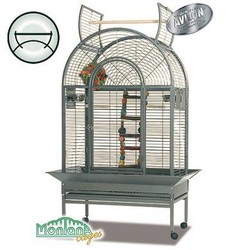
Choosing the right cage for your bird can be quite confusing as there are many different types available for sale. As a general rule, it should be big enough for your bird to be able to spread it's wings and have enough room to allow plenty of movement and play space even if your bird is not kept in its cage all of the time.
*Cage size: the bigger the better. You'll need a large cage for these guys. I would recommend a minimum in the area of 3 feet by 2 feet by 4 feet tall, but bigger is definitely better when it comes to housing parrots.
*The bar spacing should be 3/4 to 1 inch (best to get 3/4 inch spacing for a Timneh).
*At least part of the cage should have horizontally oriented bars to allow the parrot to climb on the sides of the cage.
*Perches should be of varied thickness but as a general rule your birds toes should go about 2/3 or 3/4 of the way around the perch. If perches are too thin, balance is affected and foot problems may also occur.
*Feed pots often come fitted into the cage. These are great for gaining acsess to them from the outside of the cage if your bird is a biter, but they are usually situated very low down where droppings and other bits and bobs can fall into them. Birds usually prefer to use the top of their cage too, especially timid ones who are often very reluctant to visit the lower perches of their cage. It may be an idea to purchase some hook on stainless steel coop cups as an additional easy clean addition to your cage.
* A good locking system is essential if you are to take your bird outside for fresh air in the warmer months, so check all doors and catches regularly. Extra security can be added by using mini padlocks and other secure locks for peace of mind.
*There are lots of great perches on the market now. Plastic perches are not good. These will need changing for natural wood ones or some natural branches from a non-toxic tree. Sandy ones and mineral block ones are also great and come in some lovely bright and attractive colours. If you are able to combine a mix of all types of perches then your bird will benefit greatly from all the different textures and thicknesses.
*In my opinion an open top or play top cage is a must have. These are fantastic for training purposes and out of the cage activity. Some cages have a play stand secure on top of the cage which cannot be removed. These are great for already tame birds which can be picked up and placed on the top or will readily climb or fly up there themselves. If your bird is not so tame, I would recommend one where the roof opens up and a perch is placed between the two roof sections to make a stand. The reason being, a less tame bird should be able top climb out of its cage through the open roof and onto the stand. Less tame birds who cannot be handled and are less likely to feel confident enough to climb down low through the door, will usually feel comfortable climbing up to the highest point of the cage and sit comfortably on the perch. These cages are great space savers too- no need for a seperate stand!
*Wheels are great to have on a cage too- for easy mobility and trips to the balcony or garden on a sunny day!
* Always check a cage for ease of cleaning- slide out secure trays etc. What may look nice is not always the most practical!
*Cage size: the bigger the better. You'll need a large cage for these guys. I would recommend a minimum in the area of 3 feet by 2 feet by 4 feet tall, but bigger is definitely better when it comes to housing parrots.
*The bar spacing should be 3/4 to 1 inch (best to get 3/4 inch spacing for a Timneh).
*At least part of the cage should have horizontally oriented bars to allow the parrot to climb on the sides of the cage.
*Perches should be of varied thickness but as a general rule your birds toes should go about 2/3 or 3/4 of the way around the perch. If perches are too thin, balance is affected and foot problems may also occur.
*Feed pots often come fitted into the cage. These are great for gaining acsess to them from the outside of the cage if your bird is a biter, but they are usually situated very low down where droppings and other bits and bobs can fall into them. Birds usually prefer to use the top of their cage too, especially timid ones who are often very reluctant to visit the lower perches of their cage. It may be an idea to purchase some hook on stainless steel coop cups as an additional easy clean addition to your cage.
* A good locking system is essential if you are to take your bird outside for fresh air in the warmer months, so check all doors and catches regularly. Extra security can be added by using mini padlocks and other secure locks for peace of mind.
*There are lots of great perches on the market now. Plastic perches are not good. These will need changing for natural wood ones or some natural branches from a non-toxic tree. Sandy ones and mineral block ones are also great and come in some lovely bright and attractive colours. If you are able to combine a mix of all types of perches then your bird will benefit greatly from all the different textures and thicknesses.
*In my opinion an open top or play top cage is a must have. These are fantastic for training purposes and out of the cage activity. Some cages have a play stand secure on top of the cage which cannot be removed. These are great for already tame birds which can be picked up and placed on the top or will readily climb or fly up there themselves. If your bird is not so tame, I would recommend one where the roof opens up and a perch is placed between the two roof sections to make a stand. The reason being, a less tame bird should be able top climb out of its cage through the open roof and onto the stand. Less tame birds who cannot be handled and are less likely to feel confident enough to climb down low through the door, will usually feel comfortable climbing up to the highest point of the cage and sit comfortably on the perch. These cages are great space savers too- no need for a seperate stand!
*Wheels are great to have on a cage too- for easy mobility and trips to the balcony or garden on a sunny day!
* Always check a cage for ease of cleaning- slide out secure trays etc. What may look nice is not always the most practical!
Cage Carriers
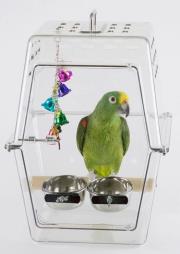
These are great, easy to clean carriers! They are very expensive but come with some great gadgets at an extra cost, fitted covers etc. My only concern would be with these is, although they have full ventilation holes, the perspex material it is made from may be inclined to hold more heat on a warm day. One good aspect though is that there are no bars so your bird would be less inclined to climb around, so no bumped or knocked toes from the outside or beaks coming through the bars when you least expect them.
Parrot Back Pack
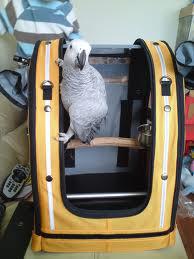
How about a parrot back pack for walkers!! A great idea for birds that want to get out and about! When buying any carriers made from a fabric, you must insure that your bird cannot chew through and escape so check the design very carefully. Also remember to check the locking system is secure, a single zip would be light work for a parrot to unfasten. Overall great for a little adventure!
PET CARRIER REVIEW
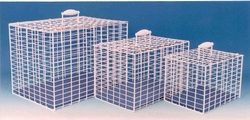
This type of carrier is great and what I use for all my birds. The bars make it easy to insert a perch and food pots if required. They usually come with a removable pad in the bottom which can easily be replaced or covered with a towel for absorbency and grip. They have a full opening top with a strong secure rod slotted through loops to so that the bird cannot reach an unlock and a secure carry handle on the top. They are also easy to clean and a very reasonable price.
PERCHES
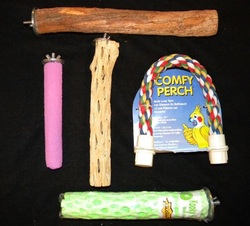
PERCH RULES
By Christine Fraser
There are many different types of perches on the market today that are fantastic for many different reasons. But I will start with basic perching as I think its something which should be provided along side any of the fancy perches which can also be added to your parrots surroundings.
Basic perches are what I would describe as your usual perches that come along with most parrot cages. These are usually smooth, rounded dowel lengths of wood which are untreated. As a rule all parrots should be provided with these as the offer the perfect texture, size and shape for your parrot to grip and have a steady footing. The size of these perches MUST be so that the tips of your parrots toes go round the perch 3/4 or 2/3rd's of the way around the perch. If your parrots toes go round the perch and touch or overlap then these perches are too small! Using perches which are too small can cause serious foot problems and affect your parrots balance! So if you have perches like these- throw them away, they are harming your bird!
On the other hand, If your birds toes only reach half or less of the way around the perch - they are too big and your parrot will not be able to get a good grip and will slip and slide and possibly fall and hurt itself- so if you have perches like these too please remove them for a more suitable size, you would not wear shoes that do not fit and damage your feet so why should this be acceptable for your parrot? Remember parrots are on their feet all the time even while they sleep so it is essential that you provide the perfect size perches for them to be comfortable.
All perches provided should be made from untoxic materials, wood especially natural branches are perfect for everyday use perches. Plastic perches are not good for your parrots feet so avoid these. They should also all be of a rounded shape, can you imagine how uncomfortable a parrots foot would be on a square perch when there feet are designed to curl?
FANCY PERCHES
These are the new style perches that are now available to us. There are many different types suitable for different purposes and I have to say I love these! Calcium perches and mineral perches for chewing to provide essential minerals and keep the beak trim, Grapevine perches and Java for a natural feel and varied thicknesses to exercise the feet, Sandy perches for keeping nails and beaks trim and many, many more!
These perches are fantastic and are great to use along side your basic perches. Although I would not recommend using only these as the textures are not suitable for all the time use.
Sandy perches work great if there is one positioned near a pot of fruit, veg or gooey food as your parrot will use the perch to wipe his/her beak during eating these kind of messy foods and when they do this they sand down the horney layers of their beak keeping them smooth and well manicured. If your parrot was on sandy perches only all day then this may dry out the feet and make them sore but for the times when they are eating they are superb. So as you can see these perches have fantastic value if they are positioned in the right place and not the only perches provided.
NATURAL BRANCHES
Natural branches are fantastic and a cheap way of providing extra perches for your parrot. Using branches of various thicknesses from a non toxic untreated tree ( list on website ) You are giving your parrot the most natural feeling perch beneath their feet! Birds and trees were designed for each other! Although your main perches should be of a comfortable size as I have stated above, providing your parrot with a variety of perch thicknesses to walk along will exercise your birds feet. Parrots feet are very muscular and varying his/her grip on different size branches while they are active will help develop strong healthy feet. Parrots love chewing the natural bark from these branches too which exercises the beak and also keeps it trim.
Ropes
Ropes also make great perches. These also need to be of a comfortable size using the 2/3 rds or 3/4 of a way around the perch rule in order to get a good grip. Although ropes do not make a stable perch for parrots, they are natural climbers and swingers so fully enjoy the use of ropes. They do offer very little good value to the feet but are great fun :)
By Christine Fraser
There are many different types of perches on the market today that are fantastic for many different reasons. But I will start with basic perching as I think its something which should be provided along side any of the fancy perches which can also be added to your parrots surroundings.
Basic perches are what I would describe as your usual perches that come along with most parrot cages. These are usually smooth, rounded dowel lengths of wood which are untreated. As a rule all parrots should be provided with these as the offer the perfect texture, size and shape for your parrot to grip and have a steady footing. The size of these perches MUST be so that the tips of your parrots toes go round the perch 3/4 or 2/3rd's of the way around the perch. If your parrots toes go round the perch and touch or overlap then these perches are too small! Using perches which are too small can cause serious foot problems and affect your parrots balance! So if you have perches like these- throw them away, they are harming your bird!
On the other hand, If your birds toes only reach half or less of the way around the perch - they are too big and your parrot will not be able to get a good grip and will slip and slide and possibly fall and hurt itself- so if you have perches like these too please remove them for a more suitable size, you would not wear shoes that do not fit and damage your feet so why should this be acceptable for your parrot? Remember parrots are on their feet all the time even while they sleep so it is essential that you provide the perfect size perches for them to be comfortable.
All perches provided should be made from untoxic materials, wood especially natural branches are perfect for everyday use perches. Plastic perches are not good for your parrots feet so avoid these. They should also all be of a rounded shape, can you imagine how uncomfortable a parrots foot would be on a square perch when there feet are designed to curl?
FANCY PERCHES
These are the new style perches that are now available to us. There are many different types suitable for different purposes and I have to say I love these! Calcium perches and mineral perches for chewing to provide essential minerals and keep the beak trim, Grapevine perches and Java for a natural feel and varied thicknesses to exercise the feet, Sandy perches for keeping nails and beaks trim and many, many more!
These perches are fantastic and are great to use along side your basic perches. Although I would not recommend using only these as the textures are not suitable for all the time use.
Sandy perches work great if there is one positioned near a pot of fruit, veg or gooey food as your parrot will use the perch to wipe his/her beak during eating these kind of messy foods and when they do this they sand down the horney layers of their beak keeping them smooth and well manicured. If your parrot was on sandy perches only all day then this may dry out the feet and make them sore but for the times when they are eating they are superb. So as you can see these perches have fantastic value if they are positioned in the right place and not the only perches provided.
NATURAL BRANCHES
Natural branches are fantastic and a cheap way of providing extra perches for your parrot. Using branches of various thicknesses from a non toxic untreated tree ( list on website ) You are giving your parrot the most natural feeling perch beneath their feet! Birds and trees were designed for each other! Although your main perches should be of a comfortable size as I have stated above, providing your parrot with a variety of perch thicknesses to walk along will exercise your birds feet. Parrots feet are very muscular and varying his/her grip on different size branches while they are active will help develop strong healthy feet. Parrots love chewing the natural bark from these branches too which exercises the beak and also keeps it trim.
Ropes
Ropes also make great perches. These also need to be of a comfortable size using the 2/3 rds or 3/4 of a way around the perch rule in order to get a good grip. Although ropes do not make a stable perch for parrots, they are natural climbers and swingers so fully enjoy the use of ropes. They do offer very little good value to the feet but are great fun :)
